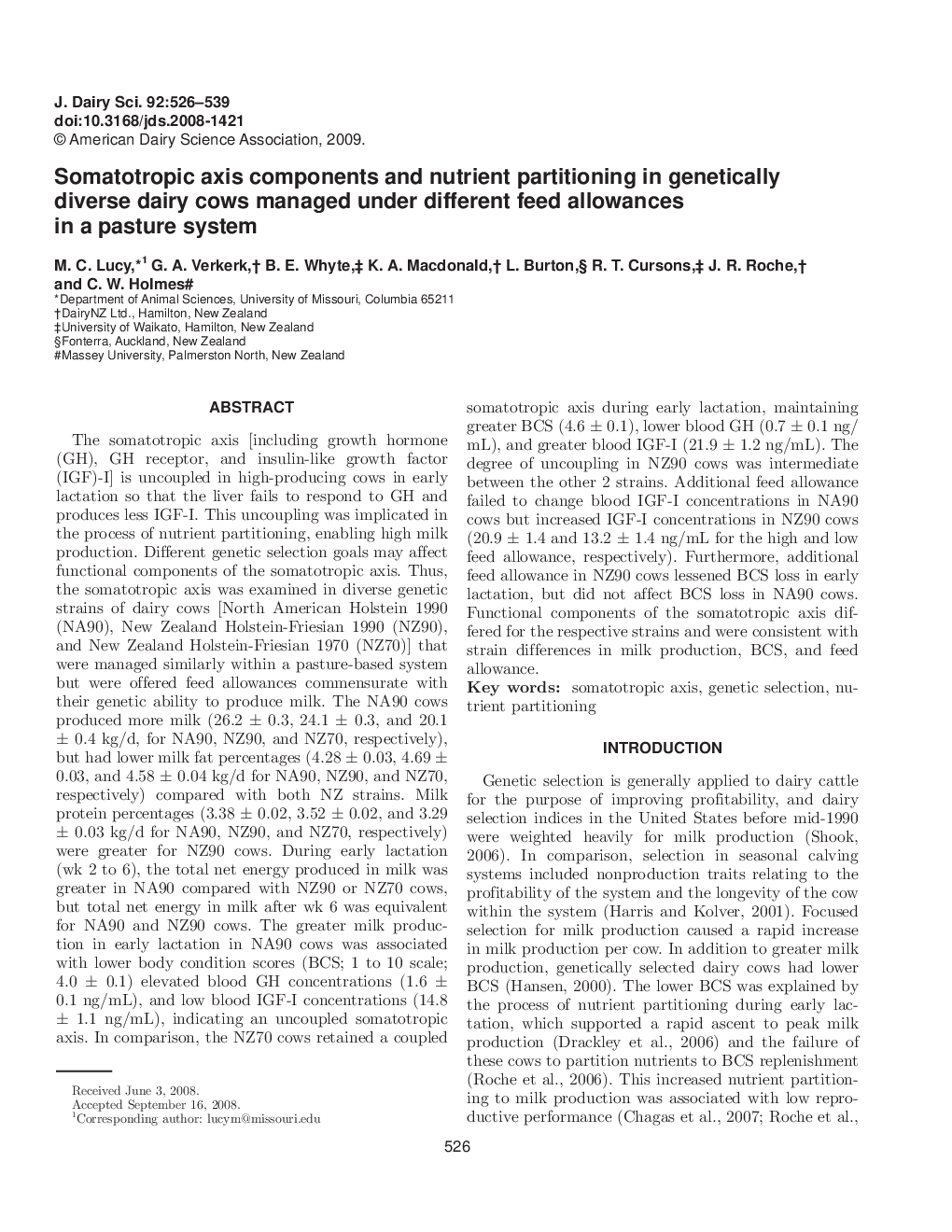| کد مقاله | کد نشریه | سال انتشار | مقاله انگلیسی | نسخه تمام متن |
|---|---|---|---|---|
| 2439399 | 1108096 | 2009 | 14 صفحه PDF | دانلود رایگان |

The somatotropic axis [including growth hormone (GH), GH receptor, and insulin-like growth factor (IGF)-I] is uncoupled in high-producing cows in early lactation so that the liver fails to respond to GH and produces less IGF-I. This uncoupling was implicated in the process of nutrient partitioning, enabling high milk production. Different genetic selection goals may affect functional components of the somatotropic axis. Thus, the somatotropic axis was examined in diverse genetic strains of dairy cows [North American Holstein 1990 (NA90), New Zealand Holstein-Friesian 1990 (NZ90), and New Zealand Holstein-Friesian 1970 (NZ70)] that were managed similarly within a pasture-based system but were offered feed allowances commensurate with their genetic ability to produce milk. The NA90 cows produced more milk (26.2 ± 0.3, 24.1 ± 0.3, and 20.1 ± 0.4 kg/d, for NA90, NZ90, and NZ70, respectively), but had lower milk fat percentages (4.28 ± 0.03, 4.69 ± 0.03, and 4.58 ± 0.04 kg/d for NA90, NZ90, and NZ70, respectively) compared with both NZ strains. Milk protein percentages (3.38 ± 0.02, 3.52 ± 0.02, and 3.29 ± 0.03 kg/d for NA90, NZ90, and NZ70, respectively) were greater for NZ90 cows. During early lactation (wk 2 to 6), the total net energy produced in milk was greater in NA90 compared with NZ90 or NZ70 cows, but total net energy in milk after wk 6 was equivalent for NA90 and NZ90 cows. The greater milk production in early lactation in NA90 cows was associated with lower body condition scores (BCS; 1 to 10 scale; 4.0 ± 0.1) elevated blood GH concentrations (1.6 ± 0.1 ng/mL), and low blood IGF-I concentrations (14.8 ± 1.1 ng/mL), indicating an uncoupled somatotropic axis. In comparison, the NZ70 cows retained a coupled somatotropic axis during early lactation, maintaining greater BCS (4.6 ± 0.1), lower blood GH (0.7 ± 0.1 ng/mL), and greater blood IGF-I (21.9 ± 1.2 ng/mL). The degree of uncoupling in NZ90 cows was intermediate between the other 2 strains. Additional feed allowance failed to change blood IGF-I concentrations in NA90 cows but increased IGF-I concentrations in NZ90 cows (20.9 ± 1.4 and 13.2 ± 1.4 ng/mL for the high and low feed allowance, respectively). Furthermore, additional feed allowance in NZ90 cows lessened BCS loss in early lactation, but did not affect BCS loss in NA90 cows. Functional components of the somatotropic axis differed for the respective strains and were consistent with strain differences in milk production, BCS, and feed allowance.
Journal: Journal of Dairy Science - Volume 92, Issue 2, February 2009, Pages 526–539